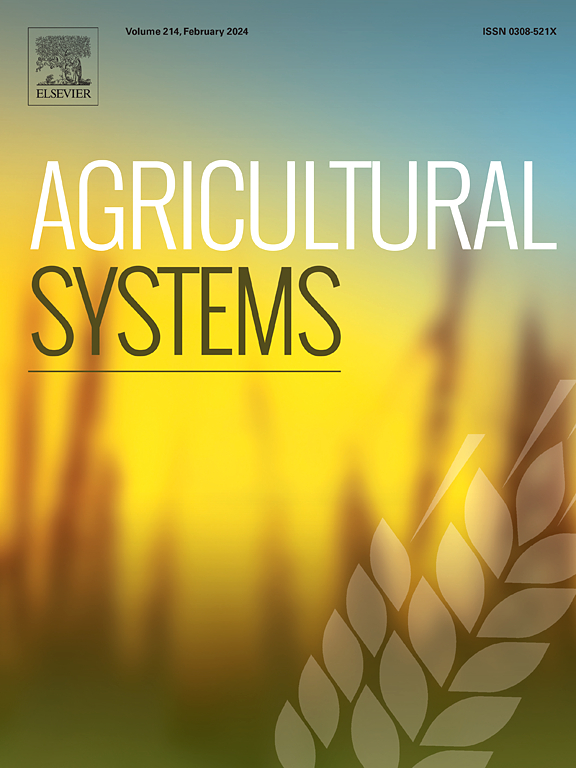从积极的偏差者的做法中学习,以提高津巴布韦混合作物-牲畜系统的性能
IF 6.1
1区 农林科学
Q1 AGRICULTURE, MULTIDISCIPLINARY
引用次数: 0
摘要
在津巴布韦,气候变化、营养饲料不足、土壤肥力差和资源权衡等因素阻碍了从事作物-牲畜混合耕作的小农的农业生产力。尽管存在这些挑战,这些社区中的积极偏差者(pd)利用与其他农民相似的资源取得了更好的成果。目的:本研究旨在确定使低效率农场优于低效率农场(LEFs)的作物-牲畜做法,并比较它们的农场生产力(能量输出)、农田添加的养分量、作物生产的毛利率和投资回报率(ROI)。方法利用2021年在津巴布韦Mutoko和Buhera地区进行的调查数据,得出每个地区的农场类型,并确定农场类型中的pd和LEFs。对选定的农场进行了详细调查,以确定其具体做法。结果与结论:与贫困农户相比,贫困农户的作物生产率显著提高86%、89%和28%,在条件较好的农场、一般农场和资源较差的农场,贫困农户的牲畜生产率分别提高156%、101%和136%。与欠发达国家相比,欠发达国家的种植面积更大(平均多42%),拥有的牲畜更多(tlu多39%),但这并不能完全解释生产力的差异。与欠发达国家相比,欠发达国家在作物生产中使用了更多的投入物(肥料、劳动力和其他),并向土壤中添加了更多的碳和氮。在这两个地区,pd在毛利率和投资回报率方面一直优于lef。贫困农民和贫困农民在经济表现上的差异在较富裕的农民中更为明显。促进畜牧场成功的关键做法包括推荐使用肥料、及时操作、牲畜补充喂养、饲料生产以及遵守推广建议。购买种子、化肥和兽药的资金短缺以及难以获得信息,都可能阻碍欠发达地区农民采用PD做法。农场类型学和PD方法的结合有助于根据该地区实施的成功实践,为不同资源禀赋的农场量身定制建议。本文章由计算机程序翻译,如有差异,请以英文原文为准。

Learning from positive deviants' practices to improve the performance of mixed crop-livestock systems in Zimbabwe
CONTEXT
In Zimbabwe, farm productivity of smallholder farmers practising mixed crop-livestock farming is hindered by climate variability, inadequate nutritious feeds, poor soil fertility, and resource trade-offs. Despite these challenges, positive deviants (PDs) within these communities achieve better outcomes using resources similar to those of other farmers.
OBJECTIVE
This study sought to identify crop-livestock practices that enable PDs to outperform low-efficiency farms (LEFs) and to compare their farm productivity (energy output), nutrient quantities added to croplands, gross margins and return on investment (ROI) from crop production.
METHODS
Data from a survey conducted in Mutoko and Buhera districts of Zimbabwe in 2021 were used to derive a farm typology per district and identify PDs and LEFs within farm types. Selected farms were subjected to detailed surveys to identify their specific practices.
RESULTS AND CONCLUSIONS
Compared to LEFs, PD farmers achieved significantly greater crop productivity — by 86 %, 89 % and 28 % — and livestock productivity — by 156 %, 101 % and 136 % on better-off, average and poorly-resourced farms, respectively. PDs had larger cropping areas (on average 42 % more) and owned more livestock (39 % more TLUs) than LEFs, but this does not fully explain differences in productivity.
PDs used more inputs (fertilizer, labour and others) for crop production than LEFs and added more carbon and nitrogen to their soils. In both districts, PDs consistently outperformed LEFs in gross margins and ROI. The differences in economic performance between PDs and LEFs were more pronounced among the better-off farmers.
Key practices contributing to PDs' success included recommended fertilizer use, timely operations, livestock supplementary feeding, fodder production, and adherence to extension advice. Financial shortages for the purchase of seeds, fertilizers, and veterinary drugs and poor access to information are potential hindrances to the adoption of PD practices by LEF farmers.
SIGNIFICANCE
The combination of a farm typology and the PD approach helped to tailor recommendations to farms differing in resource-endowment, based on successful practices implemented in the region.
求助全文
通过发布文献求助,成功后即可免费获取论文全文。
去求助
来源期刊

Agricultural Systems
农林科学-农业综合
CiteScore
13.30
自引率
7.60%
发文量
174
审稿时长
30 days
期刊介绍:
Agricultural Systems is an international journal that deals with interactions - among the components of agricultural systems, among hierarchical levels of agricultural systems, between agricultural and other land use systems, and between agricultural systems and their natural, social and economic environments.
The scope includes the development and application of systems analysis methodologies in the following areas:
Systems approaches in the sustainable intensification of agriculture; pathways for sustainable intensification; crop-livestock integration; farm-level resource allocation; quantification of benefits and trade-offs at farm to landscape levels; integrative, participatory and dynamic modelling approaches for qualitative and quantitative assessments of agricultural systems and decision making;
The interactions between agricultural and non-agricultural landscapes; the multiple services of agricultural systems; food security and the environment;
Global change and adaptation science; transformational adaptations as driven by changes in climate, policy, values and attitudes influencing the design of farming systems;
Development and application of farming systems design tools and methods for impact, scenario and case study analysis; managing the complexities of dynamic agricultural systems; innovation systems and multi stakeholder arrangements that support or promote change and (or) inform policy decisions.
 求助内容:
求助内容: 应助结果提醒方式:
应助结果提醒方式:


